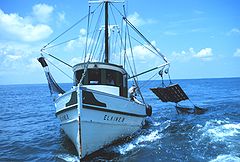Fishery
|
|||||
- See also: fishing and fishing industry

Generally, a fishery is a unit, engaged in raising and/or harvesting fish, which is determined by an authority or other entity to be a fishery. Typically, the unit is defined in terms of the following: people involved, species or type of fish, area of water or seabed, method of fishing, class of boats and purpose of the activities.[1][2]
In particular, the term is often applied to a combination of fish and fishers in a region, the latter fishing for similar species with similar gear types.[3]
A fishery may involve the capture of wild fish or raising fish through aquaculture.[2] [4]
Contents |
The term "fish"
- In biology – the term "fish" is most strictly used to describe any animal with a backbone that has gills throughout life and has limbs, if any, in the shape of fins.[5] Many types of aquatic animals commonly referred to as "fish" are not fish in this strict sense; examples include shellfish, cuttlefish, starfish, crayfish and jellyfish. In earlier times, even biologists did not make a distinction - sixteenth century natural historians classified also seals, whales, amphibians, crocodiles, even hippopotamuses, as well as a host of aquatic invertebrates, as fish.[6]
- In fisheries – the term "fish" is used as a collective term, and includes mollusks, crustaceans and any aquatic animal which is harvested.[2] True fish are sometimes referred to as finfish or fin fish to distinguish them from other aquatic life harvested in fisheries or aquaculture.
Types of fisheries
Fisheries are harvested for their value (commercial, recreational or subsistence). They can be saltwater or freshwater, wild or farmed. Examples are the salmon fishery of Alaska, the cod fishery off the Lofoten islands, the tuna fishery of the Eastern Pacific, or the shrimp farm fisheries in China.
Most fisheries are marine, rather than freshwater; most marine fisheries are based near the coast. This is not only because harvesting from relatively shallow waters is easier than in the open ocean, but also because fish are much more abundant near the coastal shelf, due to coastal upwelling and the abundance of nutrients available there. However, productive wild fisheries also exist in open oceans, particularly by seamounts, and inland in lakes and rivers.
Most fisheries are wild fisheries, but increasingly fisheries are farmed. Farming can occur in coastal areas, such as with oyster farms,[7] but more typically occur inland, in lakes, ponds, tanks and other enclosures.
There are species fisheries worldwide for finfish, mollusks and crustaceans, and by extension, aquatic plants such as kelp. However, a very small number of species support the majority of the world’s fisheries. Some of these species are herring, cod, anchovy, tuna, flounder, mullet, squid, shrimp, salmon, crab, lobster, oyster and scallops. All except these last four provided a worldwide catch of well over a million tonnes in 1999, with herring and sardines together providing a harvest of over 22 million metric tons in 1999. Many other species as well are harvested in smaller numbers.
See also
- Aquatic ecosystem
- Fish farming
- Fisheries management
- Fisheries science
- Wild fisheries
- Ocean fisheries
- Population dynamics of fisheries
- Sea Fish Industry Authority
References
- ↑ Fletcher, WJ; Chesson, J; Fisher, M; Sainsbury KJ; Hundloe, T; Smith, ADM and Whitworth, B (2002) The "How To" guide for wild capture fisheries. National ESD reporting framework for Australian fisheries: FRDC Project 2000/145. Page 119–120.
- ↑ 2.0 2.1 2.2 FAO: Fisheries glossary
- ↑ Madden, CJ and Grossman, DH (2004) A Framework for a Coastal/Marine Ecological Classification Standard. NatureServe, page 86. Prepared for NOAA under Contract EA-133C-03-SE-0275
- ↑ NOAA: Fisheries glossary p. 24.
- ↑ Nelson, Joseph S. (2006). Fishes of the World. John Wiley & Sons, Inc.. pp. 2. ISBN 0471250317.
- ↑ Jr.Cleveland P Hickman, Larry S. Roberts, Allan L. Larson: Integrated Principles of Zoology, McGraw-Hill Publishing Co, 2001, ISBN 0–07–290961–7
- ↑ New Zealand Seafood Industry Council. Mussel Farming.
External links
- FAO Fisheries Department and its SOFIA report
- The Fishery Resources Monitoring System (FIRMS)
- The International Institute of Fisheries Economics and Trade (IIFET)
- Dynamic Changes in Marine Ecosystems: Fishing, Food Webs, and Future Options (2006), U.S. National Academy of Sciences
- UNEP/GEF South China Sea Project and its Fisheries Refugia Portal and National Reports on Fish Stocks and Habitats in the South China Sea
|
|||||||||||||||||||||||||||||
